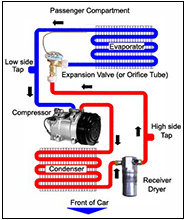Air Conditioning and Climate Control
Air Conditioning and the Environment
 Once a luxury, air conditioning is standard on almost cars sold in the US. In the past servicing an air conditioner consisted of venting the refrigerant to the atmosphere and then adding 2 or 3 cans of R-12 refrigerant. In the 1980s, scientists concluded that R-12 (a chlorofluorocarbon) was damaging the earth’s ozone layer. Because of this, new service requirements were required by the EPA. All refrigerant needed to be recovered and recycled and it became illegal to vent refrigerant to the atmosphere or to charge a known leaking system. A tax was assessed on R-12 which increased each year. In 1995 R-12, by law, was no longer manufactured. The EPA required auto makers to use a new refrigerant and the one chosen by manufacturers was R-134a. This Refrigerant also needed to be recovered and recycled because it is considered to be a greenhouse gas.
Once a luxury, air conditioning is standard on almost cars sold in the US. In the past servicing an air conditioner consisted of venting the refrigerant to the atmosphere and then adding 2 or 3 cans of R-12 refrigerant. In the 1980s, scientists concluded that R-12 (a chlorofluorocarbon) was damaging the earth’s ozone layer. Because of this, new service requirements were required by the EPA. All refrigerant needed to be recovered and recycled and it became illegal to vent refrigerant to the atmosphere or to charge a known leaking system. A tax was assessed on R-12 which increased each year. In 1995 R-12, by law, was no longer manufactured. The EPA required auto makers to use a new refrigerant and the one chosen by manufacturers was R-134a. This Refrigerant also needed to be recovered and recycled because it is considered to be a greenhouse gas.
Lubrication is Critical
R-134a is an efficient refrigerant but its ability to transport lubricant through the AC system diminishes as the pressure in the AC system drops. In other words if the system doesn’t have a full charge the compressor won’t get sufficient lubrication and could fail. If the air conditioner doesn’t seem cold enough, it could mean the charge is low. When the compressor fails, it shoots a lot of metal shavings into the system, making it necessary to replace many parts. An AC repair after a compressor failure is almost always more than $1000. If your air conditioner doesn’t feel cold enough, be sure to have the system checked for leaks.
New Enviornmental Rules in Europe
R-134a will continue to be used in the US, but will be discontinued in Europe because of its greenhouse gas properties. In about three years European manufactured vehicles will use a new refrigerant. They may just use it in their domestic market or they may use it in all vehicles domestic and export. European automakers have not yet decided on an alternative refrigerant.
Now that we can’t live without our air conditioners, we’ll just have to go with the flow when environmental concerns cause changes that may increase vehicle and repair costs.





